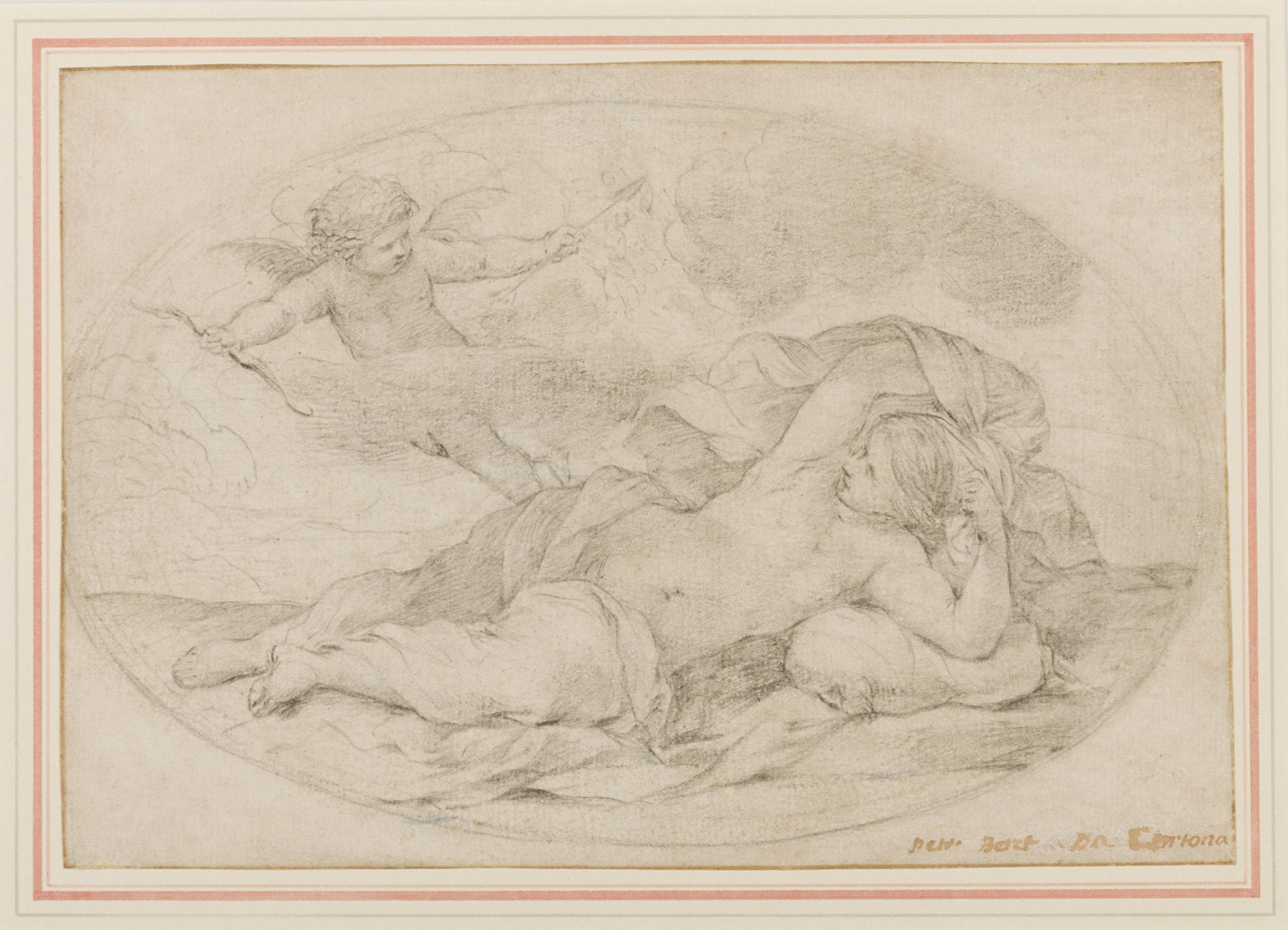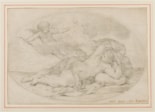Giovanni Francesco ROMANELLI
(Viterbo 1610 - Viterbo 1662)
Danaë
Sold
Black chalk, in an inscribed oval drawn in black chalk.
Inscribed Petr. Beret. Da Cortona at the lower right.
Laid down.
160 x 234 mm. (6 1/4 x 9 1/4 in.)
ACQUIRED BY THE BIBLIOTHEQUE NATIONALE DE FRANCE, PARIS.
Inscribed Petr. Beret. Da Cortona at the lower right.
Laid down.
160 x 234 mm. (6 1/4 x 9 1/4 in.)
ACQUIRED BY THE BIBLIOTHEQUE NATIONALE DE FRANCE, PARIS.
This is a preparatory study for Giovanni Francesco Romanelli’s fresco of Danaë, which, together with a pendant of Narcissus, was part of the decoration executed in 1646-1647 for the Galerie Mazarin in Paris. The compositions of both drawing and fresco are virtually identical, save for the inclusion of the arrow in Cupid’s right hand in the drawing, which was omitted in the final work.
This drawing is, in fact, one of only three known preparatory studies by Romanelli for his important fresco cycle in the Galerie Mazarin, which is today part of the site of the Bibliothèque Nationale in Paris. (As Jörg Merz has suggested, the paucity of drawings related to the Galerie Mazarin may be due to the fact that Romanelli might not have had the time to make numerous drawings for such a large and elaborate commission that was completed in about a year.) Of the other two known studies by Romanelli for the Galerie Mazarin, a lost drawing for The Judgement of Paris was formerly in the collection of the 18th century art historian Charles Rogers, and is recorded in an aquatint etching by the printmaker James Basire, while a study for The Burning of Troy appeared at auction in 1994.
Among stylistically comparable drawings by Romanelli from his Parisian period is an allegorical depiction of The Glorification of France, today in the Musée des Beaux-Arts in Lille.
This drawing is, in fact, one of only three known preparatory studies by Romanelli for his important fresco cycle in the Galerie Mazarin, which is today part of the site of the Bibliothèque Nationale in Paris. (As Jörg Merz has suggested, the paucity of drawings related to the Galerie Mazarin may be due to the fact that Romanelli might not have had the time to make numerous drawings for such a large and elaborate commission that was completed in about a year.) Of the other two known studies by Romanelli for the Galerie Mazarin, a lost drawing for The Judgement of Paris was formerly in the collection of the 18th century art historian Charles Rogers, and is recorded in an aquatint etching by the printmaker James Basire, while a study for The Burning of Troy appeared at auction in 1994.
Among stylistically comparable drawings by Romanelli from his Parisian period is an allegorical depiction of The Glorification of France, today in the Musée des Beaux-Arts in Lille.
Born in Viterbo, the painter and tapestry designer Giovanni Francesco Romanelli left the city at an early age to train as an artist in Rome. After studying with Domenichino, he entered the studio of Pietro da Cortona, becoming one the Tuscan artist’s most outstanding pupils. Romanelli assisted Cortona on the decoration of the Palazzo Barberini in Rome in 1631, and soon gained the patronage of the Barberini family himself, receiving numerous commissions from Pope Urban VIII Barberini, as well as serving as the superintendent of the Barberini tapestry manufactory, for which he provided many cartoons. The death of Urban VIII in 1644 and the decline of Barberini patronage in Rome led Romanelli to seek commissions elsewhere. Through the influence of Cardinals Antonio and Franceso Barberini, who had settled in Paris under the protection of Cardinal Jules Mazarin, Romanelli was summoned to France, where he would earn several important commissions. Among the first of these was a fresco cycle depicting scenes from Ovid’s Metamorphoses, executed in 1646-1647 for the Galerie Mazarin in Paris, which, as one modern scholar has noted, ‘represent the first painted cycle by a Roman artist in Paris after the attempts to invite Guido Reni and Cortona had failed.’ Romanelli’s frescoes were to prove highly influential for French painting of the succeeding generation. Back in Rome, he worked at the Altemps, Lante and Costaguti palaces, as well as in the church of San Marco. He was back in Paris between 1654 and 1657, when he was commissioned by King Louis XIV to paint various rooms in the Palais du Louvre, notably the summer apartments of Anne of Austria. Such was Romanelli’s stature in France that he was knighted by Louis XIV into the chivalric order of Saint-Michel. The artist spent the remainder of his career in his native Viterbo, where he worked in the Duomo.
Provenance
Yvonne Tan Bunzl, London
Andrew Smithson, Thornton Heath, Surrey
Private collection, England
Crispian Riley-Smith, Yorkshire
Private collection, New York
Thence by descent.
Andrew Smithson, Thornton Heath, Surrey
Private collection, England
Crispian Riley-Smith, Yorkshire
Private collection, New York
Thence by descent.
Literature
Bernhard Kerber, ‘Addenda zu Giovanni Francesco Romanelli’, in Giessener Beiträge zur Kunstgeschichte, 1979, p.4, pl.IV, fig.11; Jörg Martin Merz, Pietro da Cortona und sein Kreis: Die Zeichnungen in Düsseldorf, Munich and Berlin, 2005, p.181 and p.463, note 121.




